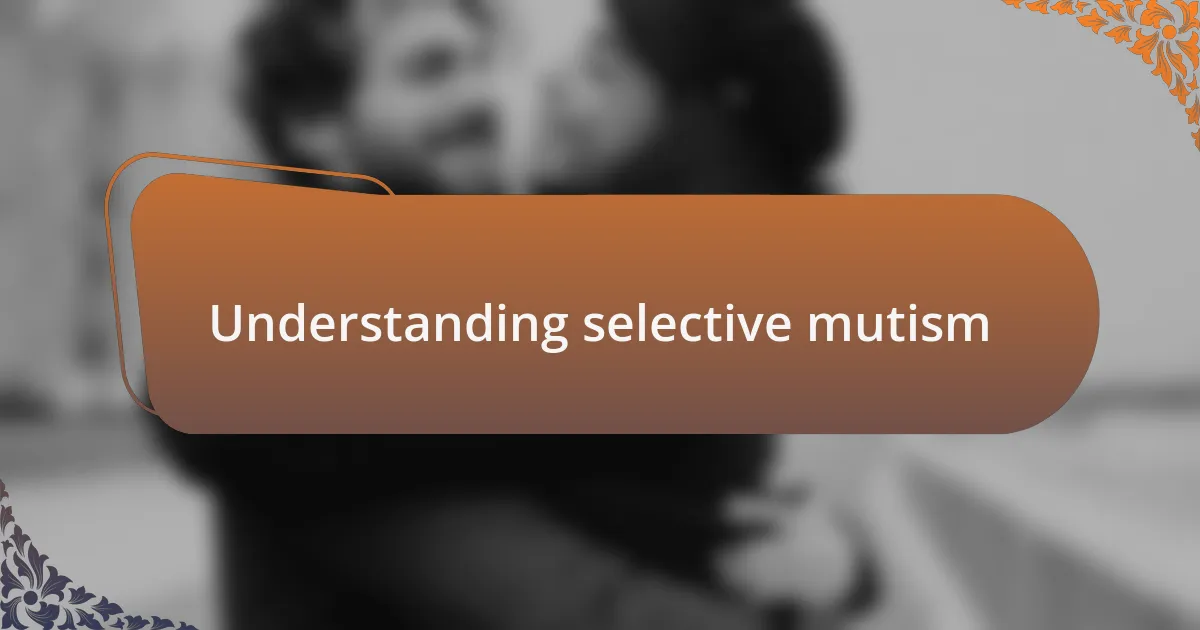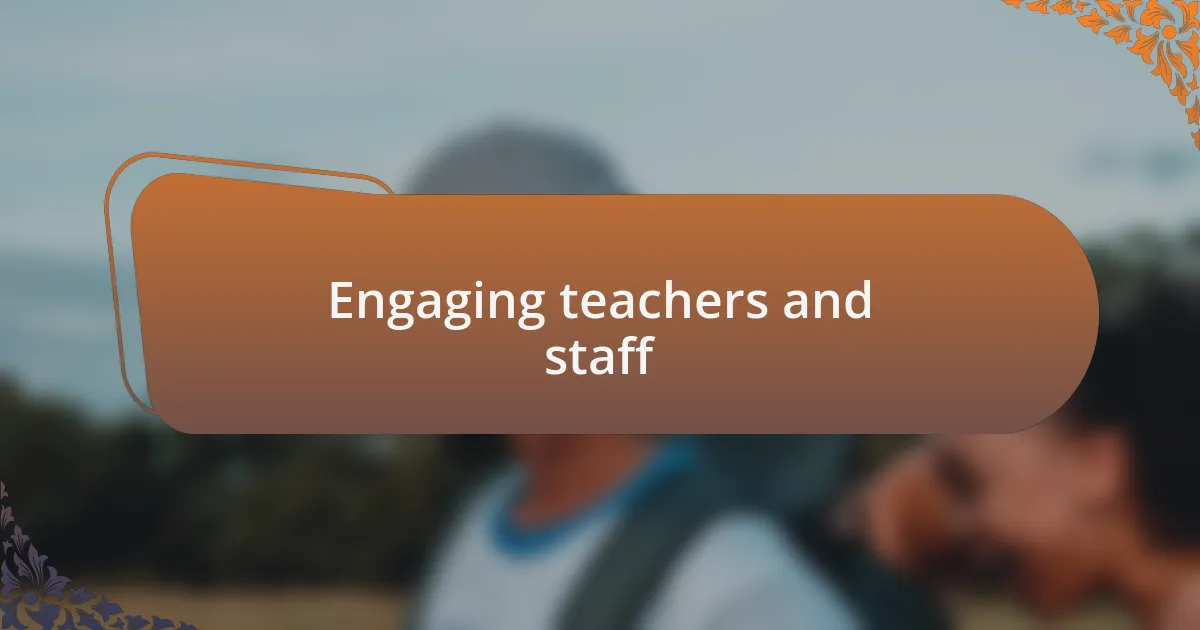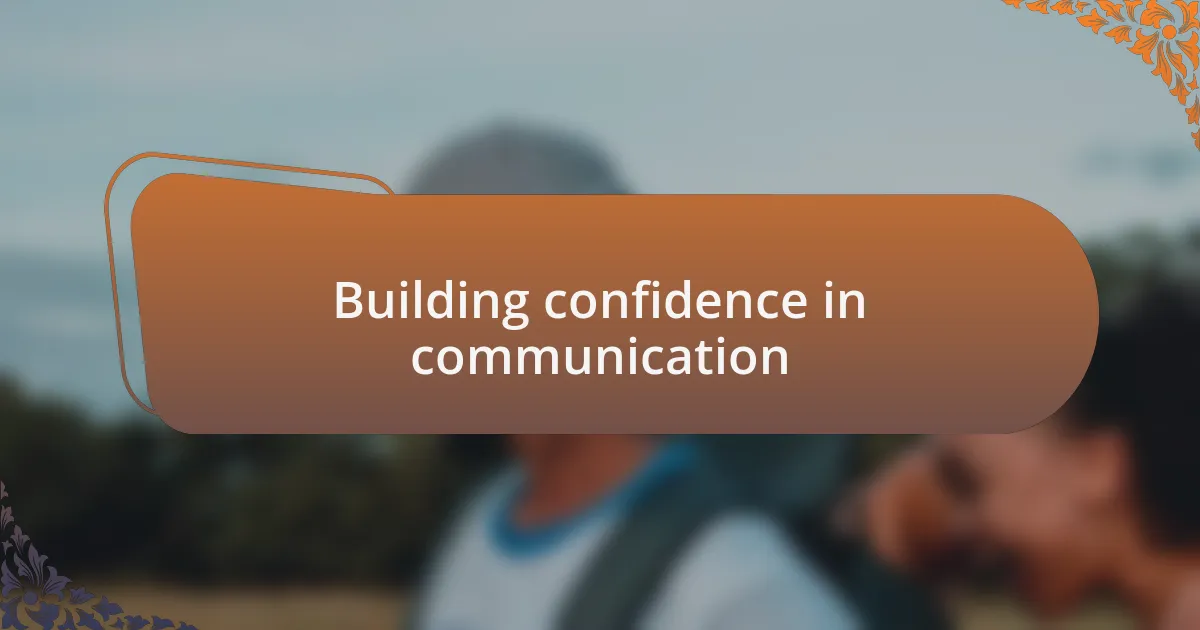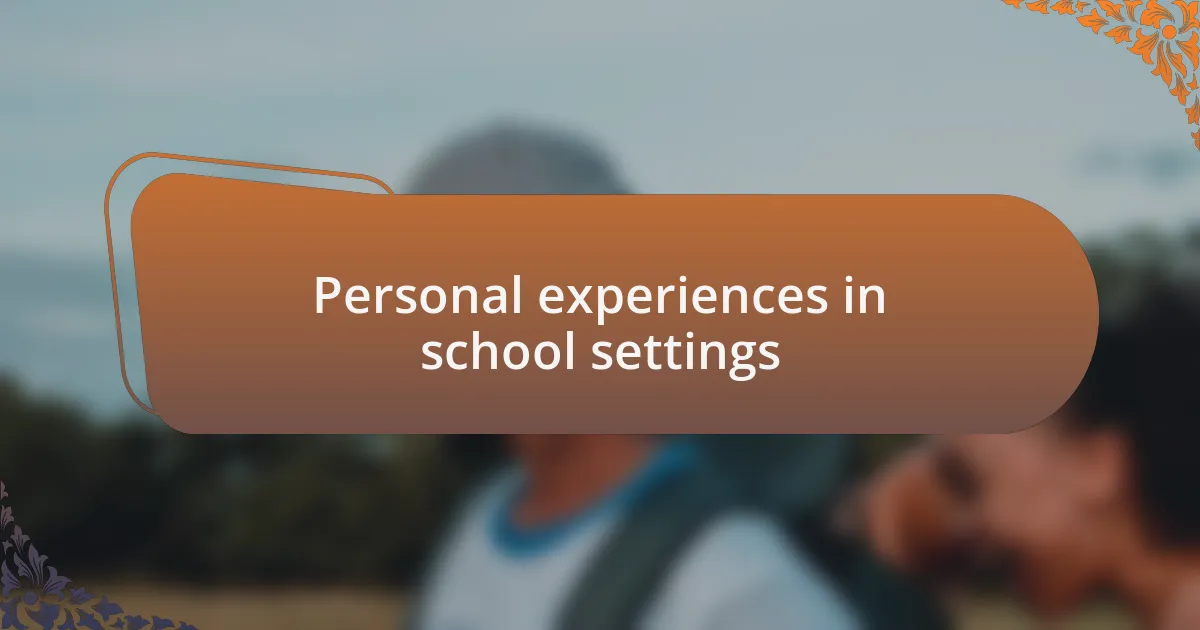Key takeaways:
- Selective mutism is an anxiety disorder that affects children’s ability to speak in specific social situations, often leading to isolation and low self-esteem.
- Awareness and understanding from educators can create a supportive environment, helping affected children feel safe and encourage communication through alternative methods.
- Engaging teachers and staff is essential, as adaptive strategies can help students navigate challenges and foster inclusivity in the classroom.
- Small, non-verbal interactions and celebrating minor progress can significantly build confidence in communication for children coping with selective mutism.

Understanding selective mutism
Selective mutism is a complex anxiety disorder often seen in children, characterized by an inability to speak in specific social settings, like school. I remember the first time I witnessed a classmate struggle in silence, sitting at a desk surrounded by friends yet not saying a word. It was heartbreaking and made me wonder just how isolating that experience must feel for them.
Often misinterpreted as mere shyness, selective mutism involves deep-rooted anxiety that can manifest as an overwhelming fear of social interaction. I can relate to feeling trapped; there were moments in my school days when even a simple classroom presentation felt daunting. How can anyone expect a child to speak in a place that feels so intimidating?
Realizing that selective mutism is not a choice but rather a coping mechanism provides a critical perspective. I recall feeling a mix of frustration and compassion during group activities; it made me reflect on how essential patience and understanding are in these environments. For those who have experienced this firsthand, it’s vital to share that you are not alone in this journey.

Effects of selective mutism
The effects of selective mutism can be profound and varied, impacting a child’s self-esteem and overall emotional well-being. I remember a classmate who would often smile and nod but never verbalize her thoughts during group discussions. It pained me to see her brilliance go unnoticed, highlighting how crucial it is for children to feel heard and valued.
Children with selective mutism face challenges beyond just communication. They may experience academic struggles due to their reluctance to participate verbally in class. I recall feeling an immense sense of anxiety myself during tests—a silent struggle that made me question my abilities, and I imagine it must be even harder for those who cannot voice their knowledge.
Social connections can also suffer significantly as a result of selective mutism. I have seen friendships falter when one child couldn’t express their feelings. It’s a reminder that words carry power; without them, building relationships can feel nearly impossible. How can we foster a welcoming environment for those who feel voiceless? Through understanding and support, we can help bridge that gap.

Importance of awareness in schools
Awareness in schools plays a crucial role in nurturing a supportive environment for children with selective mutism. I remember walking into my classroom, feeling like an outsider when I hesitated to speak. The teachers who took the time to acknowledge my struggle made all the difference; their understanding fostered a sense of safety that encouraged me to gradually find my voice.
When educators are trained to recognize the signs of selective mutism, they can implement strategies that promote communication without pressure. I recall a teacher who used creative alternatives, like written assignments or drawing, to allow me to express myself. Such methods not only validated my experiences but also opened up channels for engagement that I hadn’t known existed.
This awareness benefits not only the affected students but also the entire classroom community. By promoting empathy and understanding among peers, we can dismantle the stigma surrounding communication difficulties. Have you ever noticed how a small wave of understanding can ripple through a group, creating a more inclusive atmosphere? I believe fostering that collective awareness ultimately enriches the educational experience for everyone.

Strategies for coping in school
Creating a coping strategy in school often involves finding approaches that align with individual needs. For instance, I discovered that having a designated quiet space in the classroom was a lifesaver for me. When things felt overwhelming, I could retreat briefly to gather my thoughts – and let me tell you, that moment of solitude was priceless.
In my experience, forming a buddy system with a classmate proved invaluable. I remember one particular friend who understood my struggle and would often initiate small conversations with me. It was through these low-pressure interactions that I gradually built my confidence. Have you ever thought about how meaningful a simple gesture of companionship can be, especially for someone dealing with communication challenges?
Additionally, using technology, like speech-to-text apps, opened up new avenues for communication. I vividly recall the relief I felt when I could type out my thoughts instead of speaking them in front of the class. It made participation less daunting and created a bridge between my internal world and the classroom discussions. Have you ever found that the right tool at the right moment can change everything? It’s that kind of support that can transform the school experience for students coping with selective mutism.

Engaging teachers and staff
Engaging teachers and staff was crucial in my journey through school. I remember the moment I approached my teacher after class, sharing my struggles with speaking up in a crowded room. Her response was so supportive; she immediately suggested incorporating non-verbal signals for me to communicate when I felt overwhelmed. That small act of understanding made a world of difference. Have you ever had a teacher who genuinely listened and took action to help?
Building relationships with teachers extended beyond just conversation. I recall a time when my art teacher took notice of my discomfort during presentations. Instead of forcing me to speak, she encouraged me to express myself through my artwork, allowing me to showcase my creativity and thoughts without the pressure of verbal communication. That experience reinforced the idea that educators can adapt their teaching methods to cater to different needs. Have you ever felt like a teacher was an ally in your personal battles?
It’s remarkable how open communication with school staff can foster a supportive environment. I often found that once teachers were aware of my challenges, they offered strategies tailored to my comfort level. For example, some arranged for me to share my thoughts privately before a group discussion, easing my anxiety significantly. When educators make an effort to understand their students’ unique experiences, it creates a culture of inclusivity. Isn’t it incredible how a few simple changes can reshape a student’s learning experience?

Building confidence in communication
Building confidence in communication often requires stepping outside of our comfort zones. I vividly remember participating in a school play where I had a non-speaking role. Although I didn’t have to deliver lines, the experience of being part of a team helped me grow. It taught me that communicating doesn’t always have to be verbal; sometimes, it’s about being present and engaging with others in different ways. Have you ever felt that connection in a group setting, even without words?
Practicing small interactions can also play a significant role in building confidence. I began initiating daily greetings with classmates and gradually moved on to asking simple questions. These small wins added up, creating a sense of accomplishment. Each friendly exchange chipped away at my anxiety, slowly reshaping my self-perception. Isn’t it fascinating how interactions, no matter how brief, can empower us in unexpected ways?
Furthermore, I found that celebrating progress, no matter how minor, boosts confidence immensely. I remember when I managed to share one sentence in class; the proud feeling that washed over me was unforgettable. Encouragement from peers and teachers made me realize that every step counts on the journey to effective communication. Have you ever taken a moment to acknowledge your achievements, however small they may seem?

Personal experiences in school settings
Early school experiences were a mixed bag for me. I recall sitting in class, my heart racing during group discussions, too anxious to speak up. One day, my teacher encouraged us to partner up for a small project, and even though I was terrified of my own voice, working closely with a friend eased some of that pressure. Have you ever felt that sense of relief when a trusted person is by your side in a stressful situation?
I remember one particular day during lunchtime when a classmate invited me to join their table. The sheer act of being included felt monumental. At first, I sat in silence, observing the chatter around me. Over time, I found the courage to contribute, albeit in whispers. That slow integration into conversation taught me that it was okay to take baby steps. Have you ever realized that sometimes just being around people can pave the way for growth?
Participating in extracurricular activities proved essential in my journey. Joining a creative writing club, I discovered a safe space to express myself without the pressure of verbal communication. Sharing my written pieces felt like a breath of fresh air, as I was able to convey my thoughts without the intense anxiety of speaking in public. It made me wonder: doesn’t finding your outlet create a pathway to better communication?